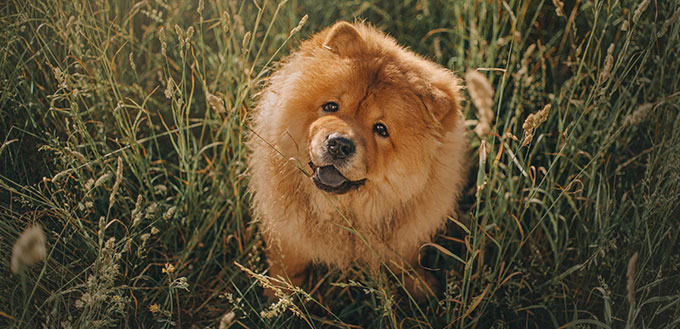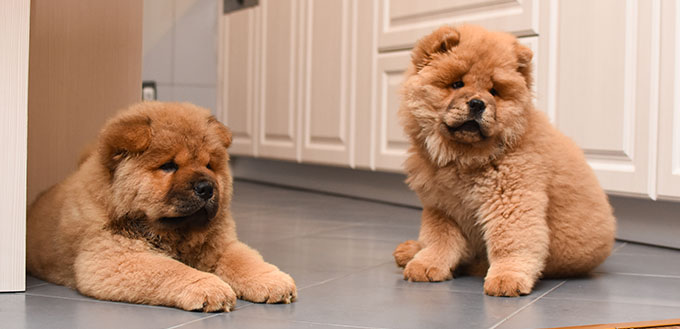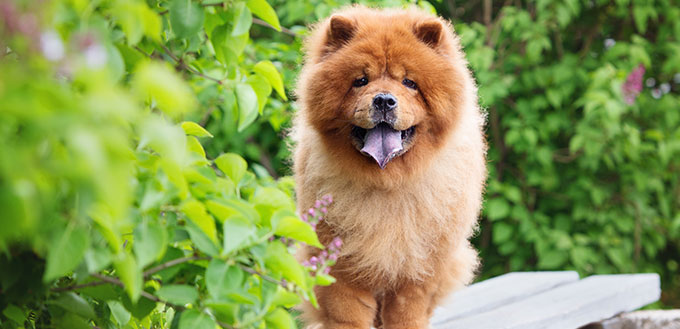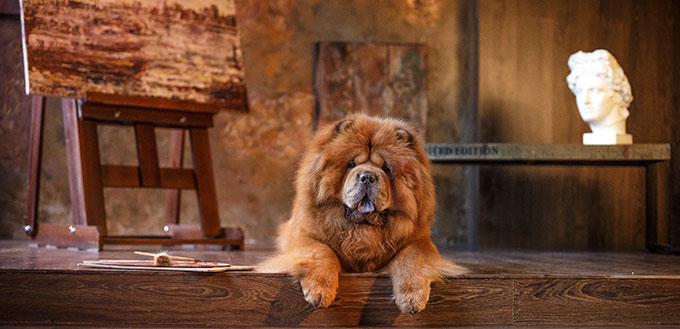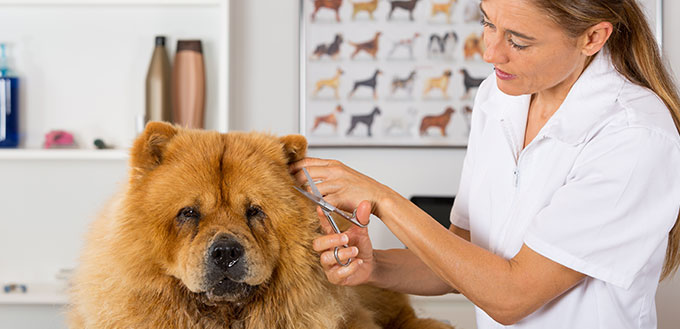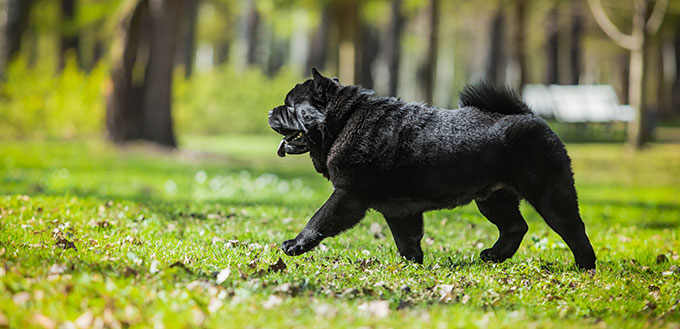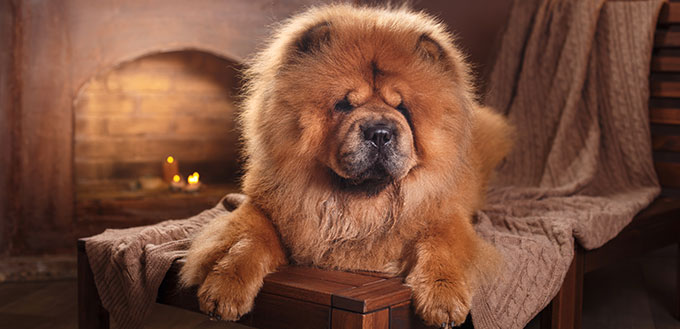Standing proud and powerful, the Chow-Chow dog breed is one of the most misunderstood dog breeds. Their impressive stature and teddy bear appearance often leaves people with the impression that this is a huggable dog, while their ancient history as a hunting and fighting dog breed has them pegged as a guard dog. Which then, is the right description? Read on, to learn everything there is to know about this unique and fascinating breed.
Breed Overview
| Dog Breed Group | Height | Weight | Life Expectancy |
|---|---|---|---|
| Working dogs | 17 to 20 inches | 40 to 70 pounds | 12 to 15 years |
Coming in a range of different colors, but always with a distinctive blue/black tongue, the Chow-Chow is a dog that always knows how to make a first impression. Their height can range from around 17 inches – or 43cm – to roughly 20 inches/50cm and can weigh up to 70 pounds – although their thick, teddy bear fur can make them appear larger than they actually are.
Chow-Chows are a working dog breed, who are at their happiest when beside their master. The average lifespan of Chow-Chows is at least 12 years, but with excellent quality food and lots of physical stimulation, Chows can live until they’re around 15 years old.
This sturdy little dog has a rich history, stemming from ancient China, and can be aloof with strangers and independent of their owners, despite being extremely loyal. They need understanding owners and lots of training to become the best dog that they can be, and so they require their master to be knowledgeable and firm-minded.
History of the Chow Chow Dog Breed
Chow-Chows are believed to be one of the oldest dog breeds in the world, with DNA testing backing up this claim. Experts believe that Chow-Chows originally hailed from Southern China or Mongolia, where the breed were known to move with nomadic Mongolian tribes. They were, for a long time, chosen by the leaders of both countries, with Chow-Chows even appearing in pottery from the Han Dynasty. One Chinese emperor kept over 2,500 dogs as pets, as well as to be used for hunting and guarding.
From what we can see in the history, the Chow-Chow breed was initially referred to by many names, including the Black-Tongue dog, Wolf Dog, Bear Dog and Canton Dog. However, the name Chow-Chow only really began to be used once merchants came on the scene and began to transport the dogs along with their cargo.
It is possible that the merchants mistook the Chinese word for dog – Gou – and pronounced it “Chow”. Another theory is that the pidgin-English word for the bits-and-pieces found on a ship were often called the “Chow Chow” – and so, the dogs were lumped in with this expression and named as just another piece of cargo.
It is believed that Chow-Chows only really became popular in the Western world after Queen Victoria took an interest in the dog breed. Being a dog-lover, and extremely influential, the dog were soon booming in popularity and a breed club was formed around Chow-Chows in 1895. The American Kennel Club officially recognized the breed not long after this, in 1903.
With such an extensive history, it’s no surprise that DNA from Chow-Chows can be found in a wide range of different breeds. From Samoyeds to Pomeranians, you can see some of the most distinctive features – including their thick fur coat – in a wide range of different dog breeds, today.
Unfortunately, their long past also means that these dogs have been used for a wide range of different purposes from dog sports, such as herding or agility, through to being used as a hunting dog and even harming each other in blood sports. Their main purpose in history, however, has been to guard their owners and their owner’s belongings.
A Few More Words About Chow Chow
Chow-Chows are a resilient breed, with relatively few health problems compared to other purebred pets and a long life span of up to 15 years. This ancient breed comes with either rough-coated or smooth-coated fur and can be relatively easy to live with, as they can be very independent and have lower energy levels than other medium-sized dogs.
They are generally wary of strangers, preferring to be beside people they know, although a well-socialized puppy can become a friendly adult dog. Chow-Chows are dogs with little tendency to wander, and will stay close to their master or home. Of course, all dogs are better suited to enclosed gardens and so we would still recommend this to anyone considering bringing home one of these beautiful dogs.
The Chow-Chow is generally an adaptable dog, that isn’t particularly sensitive to noise and can adapt well to apartment living. They do, however, have a tendency to “mouth” people and things around the home, drool and lot and generally aren’t particularly fond of being petted and loved by their owners. For this reason, they are best suited to quieter households made up of adults only, with few strangers. They are also perfectly happy to be a part of working homes, as they are very tolerant of being alone for the working day.
Chow Chow Dog Breed Appearance
| Size | Coloring | Coat Type |
|---|---|---|
| Medium Sized Dog | Red Black Blue Cinnamon Cream Blue/Black tongue | Smooth coated Rough Coat |
The Chow-Chow dog breed is sturdily built, with strong muscles backed up with dense, heavy bones. They’re considerably compact, despite being known for their big, poufy coat types, with their tail curling closely to the Chow-Chow’s back. Their hind legs have little angulation, with the joints in the hip bones sitting directly on top of each other, giving them their stilted gait and characteristic frame.
Chow-Chows have a wide flat head, with deep set eyes, and their shorter muzzle – combined with their low-set ears – give them an overall regal look. They are a compact dog, with both tail and top tucked in toward their body.
These dogs come with a variety of different coat colors, including red, black, blue, cinnamon and cream. The rarest color is the white-coated Chow, although these dogs are also more likely to come with health conditions, which may be linked to the gene responsible for the coat color. Some of these issues include hearing problems and blindness, and therefore it would seem that this coloring is being bred out due to these health conditions.
Regardless of coat color, the Chow-Chow always have tongues that are very dark blue or black. They weren’t always like this, however! It was only when managed breeding schemes began that their trademark blue-black tongue was seen, and therefore what many owners used to ensure that their Chow-Chow was a purebred dog.
As well as their coloring, it is also worth taking note of the coat type your dog has. Chow breeds have two distinct coats, and can come as a rough-coated chow or a smooth-coated chow. Both types have a double-coat, which will need to be cared for, in order to stop any potential build-up of dirt, skin cells and shedding fur.
Interesting Facts
- The Chow-Chow hails from China.
- Their Chinese name is actually ‘songshi quan’. The name ‘Chow-Chow’ is thought to come from the merchants who brought them to the Western world.
- It is thought they wandered with nomads through Southern China and Mongolia.
- They are one of the oldest dog breeds.
- It is thought that their DNA can be found in hundreds of other dog breeds.
- The Chow-Chow has two extra teeth! While most other dogs have 42, Chow-Chows have 44.
- The Chow-Chow tongue color is always a dark blue or black.
- They aren’t good swimmers, as their coat can soon become bogged down with water and exhaust your dog before long.
- The Chow-Chow is known as the cat of the dog world, due to their aloofness and independent nature.
- This breed has been used for almost every working scenario you can imagine – from pulling sleds to herding.
- Sigmund Freud was a big fan of this dog breed and had a pet Chow-Chow, called Jofi. Jofi would even sit in sessions with his master, as it helped to make patients feel more at ease.
- Their back legs are straight, unlike most other four-legged animals.
- Walt Disney bought his wife a Chow-Chow, and the presentation of his puppy present was even used as inspiration for Lady’s introduction in Lady and the Tramp!
Chow Chow Temperament
Chow-Chows are great pets for those who want to make sure their dogs are happy, while they’re out at work, as they can tolerate being alone for longer periods than most dogs. This stems from their independence, which is a trait that has been bred into the dogs from their origin of guarding their ancient Chinese masters.
This is not the breed type to enjoy being fussed over, and this dog breed certainly doesn’t make for appealing lap-dogs! In fact, these breeds are better suited to a life as an adult-only pet, as they prefer to only be around one or two people, with the comings and goings of strangers being a more upsetting experience than a pleasing one. On top of this, their natural guarding instincts and desire to stay close to home mean they can adapt well to living in apartments or smaller homes.
Of course, as with any dogs, if a Chow-Chow puppy is raised to be well-socialized around people, children and other animals, then you are unlikely to have any issues with this pet. Despite some beliefs (and legislation) marking these as an aggressive dog, Chow-Chows are actually quite a friendly dog in their own way. They simply don’t enjoy being approached by strangers, without their masters introducing them, first!
The Chow-Chow also has a relatively low activity level requirement, often simply needing a couple of shorter walks every day. Again, this makes them ideal for adult-only households, as owners can go to work guilt-free, without having to worry about keeping their Chow-Chow entertained all the time. This is a dog that is easy-going and perfectly happy to be on their own – as long as they receive a good level of adult attention when their humans are back, of course.
Chow Chow Care
| Training | Feeding | Grooming | Health | Exercise |
|---|---|---|---|---|
| Relatively easy to train | Requires high-quality food | Requires daily brushing | Generally healthy | Daily walks |
| Should be socialized from a young age | Up to 1300 calories a day | A monthly bath is recommended | May suffer with eye problems and hip dysplasia | Gentle play |
Training
As with most dogs, the Chow-Chow needs to have plenty of training in order to become the obedient dog they wish to be. Puppy training classes are always recommended, to help your dogs become well-mannered and understand what you’re trying to tell them. This is a dog that wants to please, but you need to be speaking the same language, in order for them to understand and classes can help you and your pet get on the same wavelength.
Puppy classes are also a great way to get your pet to socialize with others, in both human and pet form, as they become used to being around others in a noisy, distracting environment. As Chow-Chows can be a little stubborn, it can usually help to bring them into an unfamiliar environment, where they will take your lead on how to behave from a young age.
In particular, toilet training is something that seems to come a little easier to Chows than most other dogs. It seems that this breed is one that prefers not to be near their own mess and so crate training is a great way to help speed the process along.
Feeding
Despite their larger muscle mass and dense bone structure, Chow-Chows don’t need a diet with high protein. Indeed, Chows cannot digest protein as well as other dog breeds. This is because, in the past, their diet consisted mostly of eating vegetables and grains, with the occasional addition of soy or fish. Modern Chow dogs will develop skin conditions if they are given a diet with too much protein in it, and therefore require a diet similar to those with protein sensitivity.
Instead, a Chow-Chow diet should consist of easy-to-digest, simple foods and lots of omega fatty acids to help keep their skin, brain and fur in good condition. If you’re looking to feed your Chow a raw diet, then it can worth opting for food items such as eggs and rice, instead of high-protein meats.
If you prefer to offer your dogs kibble, be sure to give them access to lots of fresh water, as their thick, double-coat will keep them extremely warm and they can become dehydrated easily.
A Chow-Chow will usually need to eat around twice a day, and a fully grown adult dog (dogs are considered a fully grown adult from the age of 2) will often have around 4 cups of kibble per day. Do be sure to check the ingredient lists on any food you choose to serve your dogs, as brand will frequently change their recipes without warning.
Grooming Requirements
Both the smooth coated chow and rough coated Chow Chow varieties require regular grooming. Both varieties have a thick double coat that needs daily brushing from a young age. When grooming your dogs, be mindful of their tail, which can often sit very close to your pet and the close coat can lead to tangles and matting.
We recommend using a slicker brush for the main body and tail of your dog, while a soft-bristle brush should be used for the shorter hair around the head. Make sure not to accidentally catch the eyes of your pup, as they are quite deep set in the head and you can easily catch them, no matter which variety of hair type they have.
You should also wash your Chow-Chow no more than once a month, with a good quality brand dog shampoo, in order to retain the oils in their skin and make sure you get a healthy-looking coat! When bathing your Chow, try to avoid the head and ears – if you do get their head wet then quickly rinse off any soap before it gets into any sensitive areas such as their eyes and dry them off.
Check out some of our dog grooming guides, such as the best shampoo for puppies, best dog shedding brush, best dog conditioners, and best dog grooming clippers.
Health
Generally speaking, the Chow-Chow is a healthy breed of dog, and is prone to very few health conditions and has a fairly long life span. As with all dogs, however, there a few things you should be aware of, such as:
Obesity
A common disease with shorter, stocky dogs is obesity. It it, however, a disease that can be easily prevented and things can even be managed if your dog does put on weight. As long as they are fed appropriate food, and given plenty of exercise, there should be no need to call your veterinarian.
You should always keep a close eye on any Chow-Chow weight gain, as they can be prone to obesity and a full grown Chow-Chow should weigh between 45-70 pounds. Your pet is also more likely to suffer from this disease as they age and move less, while puppies are much more active and less likely to put on the pounds.
Hip Dysplasia
Hip dysplasia is common in many purebred dogs, but the Chow-Chow is unique in how their hind legs sit, giving them their trademark stilted gait. This is because the bone of the thigh and hip bone sit directly on top of one another, creating a unique hip joint that can cause problems, later down the line. However, good breeders will usually work to ensure that your new pet will have had these health problems bred out through their lineage.
Ear Infections
Ear infections are one of those common issues that can occur in both puppies and fully grown Chow-Chows. Because they have such densely packed hair around their ears, it can be easy for bacteria and germs to grow in the area. For this reason, it’s worth checking the ears of your pet on a regular basis. If you do this while they are puppies, they will soon become used to you handling them – and it’ll make it easier for your veterinarian to check them over, too.
Eye Problems
Chow-Chow’s are more likely than some other dogs to suffer from issues in and around their eyes, due to their general teddy-bear appearance. Occasionally, their eyelid may become caught and roll inward – also called entropion – which can be painful for your pup. If you notice your dog is rubbing at their eyes a lot, it’s worth taking them to the vet to be checked over, as this can only be corrected surgically.
Exercising
The exercise needs of the Chow-Chow dog breed are relatively low, for such a large dog. They usually require a moderate level of activity, including a good walk each day, as well as some games. Despite having a relatively low energy level, they still require a good amount of stimulation every day – with no rough play, as this can encourage aggression.
Despite their moderate exercise requirements, owners should also be aware that it is not advised to undertake any exercise on hot days, as the Chow-Chow’s thick coat does not allow them to tolerate heat. On hot days, it’s better to take your Chow-Chows early in the morning or later at night, after the sun has set, in order to meet their needs while catering for their extra fluffy coat.
Adopt Don’t Shop (Rescue Groups)
We would always recommend adopting your dogs wherever possible. However, for breeds such as the Chow-Chow, it is essential that you are able to work with a dog that is trainable and suits your household. Some Chows are not the ideal family dog, as they may become aggressive or even possessive of one member over the rest. This is especially true if the pup is nervous due to being treated badly previously. That being said, an experienced owner who is confident in their training and socializing abilities should not have an issue with adopting their Chow-Chow.
Reputable Breeders
A good breeder of Chow-Chow puppies will be one who understands the breed, their health issues and understanding of their nature. Because the breed is likely to suffer with hip dysplasia and sight problems, it is important to find a reputable breeder who has screened the parent dogs for these issues and “bred-out” any illnesses such as these. You should also be able to meet both parents, when meeting your chow puppy for the first time, who should be at least 2 years or older at the time of breeding.
Price
When adopted, the Chow-Chow cost can vary depending on the adoption rates of the shelters or companies that you’re sourcing your new friend from. When purchased as a puppy from a breeder, the average cost of the Chow-Chow can vary from $800 to $1200. Some breeders may charge in excess of $3000 for their Chow puppies, as they come from a long line of AKC-registered Chows, and may boast of superior showing stock.
FAQ’s:
Q: Are Chow Chows aggressive?
A: When sourced from ethical Chow-Chow breeders and raised with a knowledgeable and firm family, the Chow-Chow is not aggressive. They do, however, have guarding and protective tendencies that need to be controlled with training and positive reinforcement, to help harness their aggressive streak. With good socialization from a young age and an experienced owner, you should have no problem with your Chow-Chow.
Q: Are Chow Chows banned in the US?
A: Chow-Chows are not banned in the United States. However, they are under strict regulation in terms of breeding and licensing, and may be banned in specific states. For example, in Michigan and Louisiana, these dogs are under strict control and banned from public ownership as they are “considered…as vicious and potentially dangerous”.
Q: Where does the Chow Chow rank?
A: The Chow-Chow was extremely popular in the 1980’s, but interest in the breed has waned slightly over time. Out of a total of 195 breeds recognized by the American Kennel Club, the Chow-Chow currently ranks at 75th place. You may find, however, that due to their ancient past, that their breeding shows up in a lot of doggy DNA!
Sources:
- Chow Chow Traits, VCA
- Chow Chow, Vetstreet


